An official website of the United States government
 United States Department of Labor
United States Department of Labor
REPORT (PDF)
Technical notes (PDF)
Country notes (PDF)
Tables by indicator (XLS), and tables by country (XLS)
On This Page:
|
The unemployment rate is the unemployed as a percentage of the labor force; it is the most widely used measure of an economy’s unused labor supply. In 2012, the United States had the 6th highest unemployment rate of the 16 countries covered. Spain ranked the highest followed closely by South Africa, while the Republic of Korea maintained the lowest unemployment rate for the year. For more details on unemploy-ment rates, see page 2 or the Technical Notes.
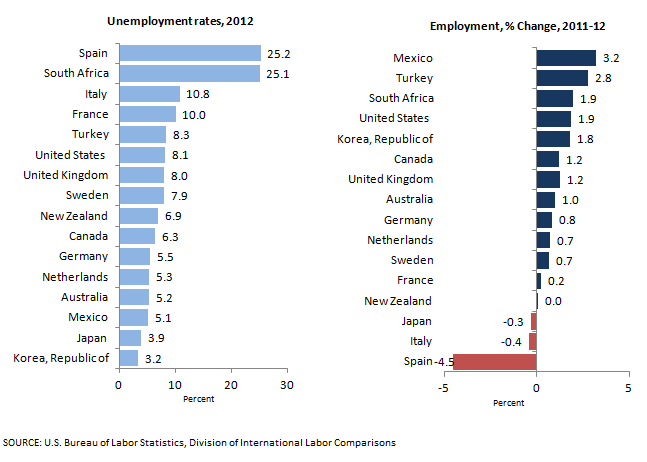
The employment growth rate measures the change in the number of persons working for a given period. From 2011 to 2012, employment increased in 12 of the 16 countries compared. Mexico had the highest growth, followed by Turkey. New Zealand showed no change. Spain experienced the steepest decline in employment. For more details on employment, see page 7 or the Technical Notes.
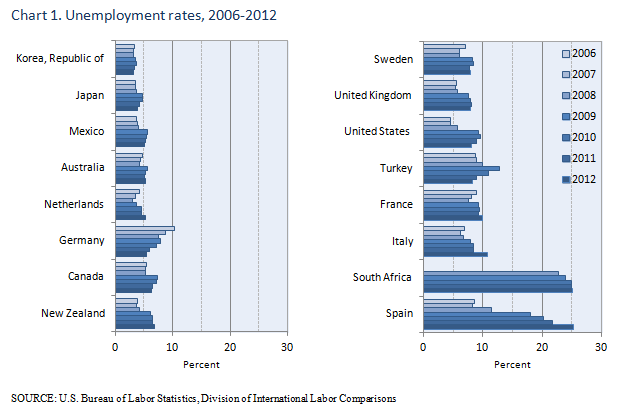
Over the last 7 years, the unemployment rates for the United States and most other countries remained below 10 percent, even during the downturn of the 2009 global recession. However, rates in Spain and South Africa were higher than 15 percent during the period.
| 1970 | 1980 | 1990 | 2000 | 2006 | 2007 | 2008 | 2009 | 2010 | 2011 | 2012 | |
|---|---|---|---|---|---|---|---|---|---|---|---|
| United States | 4.9 | 7.1 | 5.6 | 4.0 | 4.6 | 4.6 | 5.8 | 9.3 | 9.6 | 8.9 | 8.1 |
| Australia | 1.7 | 6.1 | 6.9 | 6.3 | 4.8 | 4.4 | 4.2 | 5.6 | 5.2 | 5.1 | 5.2 |
| Canada | 5.7 | 7.3 | 7.7 | 6.1 | 5.5 | 5.2 | 5.3 | 7.3 | 7.1 | 6.5 | 6.3 |
| France | 2.5 | 5.6 | 8.0 | 8.6 | 8.9 | 8.1 | 7.5 | 9.2 | 9.4 | 9.3 | 10.0 |
| Germany | 0.5 | 2.8 | 5.0 | 7.8 | 10.3 | 8.7 | 7.6 | 7.8 | 7.1 | 5.9 | 5.5 |
| Italy | 3.2 | 4.4 | 7.0 | 10.1 | 6.9 | 6.2 | 6.8 | 7.9 | 8.5 | 8.5 | 10.8 |
| Japan | 1.2 | 2.0 | 2.0 | 4.4 | 3.6 | 3.6 | 3.7 | 4.8 | 4.7 | 4.2 | 3.9 |
| Korea, Republic of | 4.4 | 5.2 | 2.4 | b 4.4 | 3.4 | 3.2 | 3.2 | 3.6 | 3.7 | 3.4 | 3.2 |
| Mexico | NA | NA | NA | NA | 3.7 | 3.8 | 4.1 | 5.6 | b 5.4 | 5.3 | 5.1 |
| Netherlands | NA | 6.0 | 7.6 | b 3.1 | 4.3 | 3.5 | 3.0 | 3.7 | b 4.5 | 4.5 | 5.3 |
| New Zealand | NA | NA | 8.0 | 6.1 | 3.8 | 3.7 | 4.2 | 6.1 | 6.5 | 6.5 | 6.9 |
| South Africa | NA | NA | NA | NA | NA | NA | 22.8 | 23.9 | 24.9 | 24.9 | 25.1 |
| Spain | NA | 11.3 | 15.2 | 12.0 | 8.6 | 8.3 | 11.4 | 18.1 | 20.2 | 21.8 | 25.2 |
| Sweden | 1.5 | 2.0 | 1.8 | 5.8 | 7.0 | 6.1 | 6.1 | 8.3 | 8.5 | 7.7 | 7.9 |
| Turkey | NA | NA | NA | NA | 8.8 | 9.0 | 9.9 | 12.8 | 10.9 | 9.0 | 8.3 |
| United Kingdom | NA | 6.8 | 7.1 | 5.5 | 5.5 | 5.4 | 5.7 | 7.6 | 7.9 | 8.1 | 8.0 |
| Note: | |||||||||||
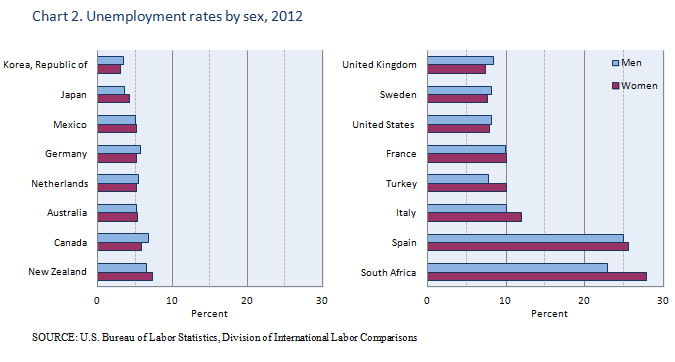
Historically, unemployment rates have been higher for women than for men; however, in recent years the reverse has been true in an increasing number of countries. In 2012, unemployment rates for men were higher than for women in 7 of the 16 countries compared: the United States, Canada, Germany, Republic of Korea, Netherlands, Sweden, and the United Kingdom.
| 2008 | 2009 | 2010 | 2011 | 2012 | ||||||
|---|---|---|---|---|---|---|---|---|---|---|
| Men | Women | Men | Women | Men | Women | Men | Women | Men | Women | |
| United States | 6.1 | 5.4 | 10.3 | 8.1 | 10.5 | 8.6 | 9.4 | 8.5 | 8.2 | 7.9 |
| Australia | 4.0 | 4.6 | 5.7 | 5.4 | 5.1 | 5.4 | 4.9 | 5.3 | 5.2 | 5.3 |
| Canada | 5.8 | 4.8 | 8.5 | 6.1 | 7.8 | 6.2 | 7.0 | 5.9 | 6.7 | 5.8 |
| France | 7.0 | 7.9 | 9.1 | 9.4 | 9.1 | 9.7 | 8.9 | 9.7 | 9.9 | 10.0 |
| Germany | 7.5 | 7.7 | 8.2 | 7.3 | 7.6 | 6.5 | 6.2 | 5.6 | 5.7 | 5.2 |
| Italy | 5.6 | 8.5 | 6.9 | 9.3 | 7.7 | 9.7 | 7.7 | 9.6 | 10.0 | 11.9 |
| Japan | 3.2 | 4.3 | 4.4 | 5.2 | 4.5 | 5.0 | 4.1 | 4.4 | 3.6 | 4.2 |
| Korea, Republic of | 3.6 | 2.6 | 4.1 | 3.0 | 4.0 | 3.3 | 3.6 | 3.1 | 3.4 | 3.0 |
| Mexico | 3.9 | 4.3 | 5.5 | 5.6 | b 5.5 | b 5.4 | 5.3 | 5.3 | 5.0 | 5.1 |
| Netherlands | 2.8 | 3.3 | 3.7 | 3.7 | b 4.4 | b 4.5 | 4.5 | 4.4 | 5.4 | 5.2 |
| New Zealand | 4.1 | 4.2 | 6.1 | 6.1 | 6.2 | 6.9 | 6.3 | 6.7 | 6.5 | 7.3 |
| South Africa | 19.8 | 26.4 | 22.0 | 26.2 | 22.8 | 27.5 | 22.5 | 27.8 | 22.9 | 27.8 |
| Spain | 10.1 | 13.1 | 17.9 | 18.5 | 19.9 | 20.6 | 21.4 | 22.2 | 24.9 | 25.5 |
| Sweden | 5.8 | 6.3 | 8.6 | 7.9 | 8.6 | 8.4 | 7.8 | 7.6 | 8.2 | 7.6 |
| Turkey | 9.6 | 10.5 | 12.6 | 13.3 | 10.4 | 12.0 | 8.3 | 10.7 | 7.7 | 10.0 |
| United Kingdom | 6.2 | 5.1 | 8.7 | 6.4 | 8.7 | 6.9 | 8.8 | 7.3 | 8.4 | 7.4 |
| Note: | ||||||||||
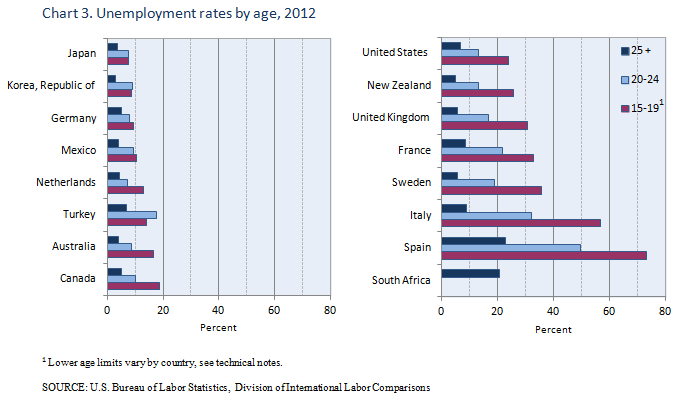
For nearly all countries shown, unemployment rates for teens (15-19) have historically been higher than rates for the other age groups compared. Turkey and the Republic of Korea were the only two countries to have higher unemployment rates for young adults (20-24) than for teens. Japan’s unemployment rates for teens and young adults were virtually the same. Spain and Italy had the largest increases in teen unemployment over the 2009-2012 period.
| 2009 | 2010 | 2011 | 2012 | |||||||||
|---|---|---|---|---|---|---|---|---|---|---|---|---|
| 15-19 | 20-24 | 25+ | 15-19 | 20-24 | 25+ | 15-19 | 20-24 | 25+ | 15-19 | 20-24 | 25+ | |
| United States | 24.3 | 14.7 | 7.9 | 25.9 | 15.5 | 8.2 | 24.4 | 14.6 | 7.6 | 24.0 | 13.3 | 6.8 |
| Australia | 16.5 | 8.2 | 4.3 | 16.8 | 8.1 | 3.8 | 16.1 | 8.3 | 3.7 | 16.7 | 8.6 | 3.9 |
| Canada | 18.5 | 11.2 | 6.1 | 18.6 | 10.7 | 5.9 | 17.7 | 10.1 | 5.4 | 18.7 | 10.0 | 5.1 |
| France | 30.9 | 21.6 | 7.6 | 29.7 | 21.4 | 7.9 | 29.4 | 20.5 | 7.9 | 32.8 | 21.9 | 8.4 |
| Germany | 11.3 | 11.1 | 7.3 | 10.7 | 9.5 | 6.8 | 10.0 | 8.2 | 5.6 | 9.2 | 7.9 | 5.2 |
| Italy | 40.3 | 23.0 | 6.5 | 45.8 | 25.0 | 7.1 | 48.7 | 26.3 | 7.0 | 56.9 | 32.1 | 9.0 |
| Japan | 9.5 | 8.9 | 4.4 | 9.9 | 9.0 | 4.3 | 9.0 | 7.9 | 3.9 | 7.6 | 7.5 | 3.5 |
| Korea, Republic of | 12.3 | 9.5 | 3.2 | 12.1 | 9.4 | 3.3 | 10.6 | 9.4 | 3.0 | 8.7 | 9.0 | 2.8 |
| Mexico | 11.2 | 10.1 | 4.3 | b 11.0 | b 9.5 | b 4.2 | 10.9 | 9.7 | 4.1 | 10.5 | 9.5 | 3.9 |
| Netherlands | 9.4 | 6.1 | 2.9 | b 11.2 | b 7.0 | b 3.7 | 10.5 | 5.7 | 3.9 | 12.8 | 7.2 | 4.5 |
| New Zealand | 23.4 | 11.5 | 4.0 | 24.7 | 12.0 | 4.5 | 25.7 | 12.2 | 4.4 | 25.8 | 13.1 | 4.9 |
| South Africa | NA | NA | 19.3 | NA | NA | 20.3 | NA | NA | 20.6 | NA | NA | 20.7 |
| Spain | 56.4 | 34.0 | 16.0 | 62.3 | 37.7 | 18.1 | 64.6 | 43.2 | 19.5 | 73.3 | 49.7 | 22.8 |
| Sweden | 35.9 | 20.0 | 5.9 | 35.6 | 19.9 | 6.2 | 33.9 | 18.1 | 5.5 | 35.8 | 19.0 | 5.7 |
| Turkey | 22.0 | 24.3 | 10.5 | 17.7 | 21.9 | 8.9 | 15.0 | 18.5 | 7.3 | 13.9 | 17.5 | 6.9 |
| United Kingdom | 26.8 | 15.3 | 5.6 | 29.1 | 15.3 | 5.8 | 31.2 | 16.5 | 5.8 | 30.5 | 16.9 | 5.7 |
| Note: | ||||||||||||
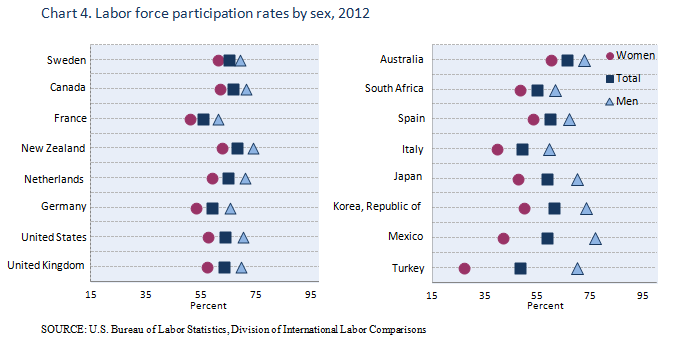
The labor force participation rate is the ratio of actual labor force (employed and unemployed) as a percent of the potential labor force (working age population). For more information, see the technical notes.
In 2012, labor force participation rates were higher for men than for women in all 16 countries compared. The lowest gender gaps were in Sweden and Canada, while the largest disparity in gender participation existed in Turkey, Mexico and the Republic of Korea.
| 2009 | 2010 | 2011 | 2012 | |||||||||
|---|---|---|---|---|---|---|---|---|---|---|---|---|
| Men | Women | Total | Men | Women | Total | Men | Women | Total | Men | Women | Total | |
| United States | 72.0 | 59.2 | 65.4 | 71.2 | 58.6 | 64.7 | 70.5 | 58.1 | 64.1 | 70.2 | 57.7 | 63.7 |
| Australia | 73.3 | 60.1 | 66.7 | 73.2 | 59.8 | 66.4 | 73.1 | 60.0 | 66.5 | 72.6 | 59.9 | 66.2 |
| Canada | 72.0 | 62.5 | 67.2 | 71.8 | 62.4 | 67.0 | 71.7 | 62.2 | 66.8 | 71.4 | 62.1 | 66.7 |
| France | 61.1 | 50.9 | 55.8 | 61.0 | 51.0 | 55.8 | 60.7 | 50.9 | 55.6 | 61.1 | 51.2 | 55.9 |
| Germany | 65.3 | 52.1 | 58.5 | 65.1 | 52.4 | 58.6 | 65.6 | 53.2 | 59.2 | 65.5 | 53.2 | 59.2 |
| Italy | 59.4 | 38.2 | 48.4 | 59.0 | 38.2 | 48.1 | 58.7 | 38.4 | 48.1 | 59.2 | 39.7 | 49.0 |
| Japan | 71.3 | 48.1 | 59.3 | 70.9 | 48.1 | 59.1 | 70.5 | 47.7 | 58.7 | 69.8 | 47.7 | 58.4 |
| Korea, Republic of | 73.1 | 49.2 | 60.8 | 73.0 | 49.4 | 61.0 | 73.1 | 49.7 | 61.1 | 73.3 | 49.9 | 61.3 |
| Mexico | 76.7 | 41.1 | 57.9 | b 76.5 | b 40.7 | b 57.6 | 76.4 | 41.2 | 57.8 | 76.7 | 42.0 | 58.4 |
| Netherlands | 72.9 | 59.8 | 66.2 | b 71.1 | b 58.4 | b 64.6 | 70.3 | 58.3 | 64.2 | 70.9 | 58.9 | 64.8 |
| New Zealand | 74.6 | 62.2 | 68.2 | 74.4 | 62.1 | 68.1 | 74.6 | 62.5 | 68.4 | 74.0 | 62.6 | 68.2 |
| South Africa | 63.7 | 49.0 | 56.1 | 61.8 | 47.4 | 54.3 | 61.2 | 47.9 | 54.3 | 61.7 | 48.3 | 54.8 |
| Spain | 68.4 | 51.4 | 59.7 | 67.8 | 52.1 | 59.8 | 67.2 | 52.8 | 59.8 | 66.7 | 53.2 | 59.8 |
| Sweden | 68.9 | 60.7 | 64.8 | 69.3 | 60.3 | 64.7 | 69.3 | 61.0 | 65.1 | 69.2 | 61.3 | 65.2 |
| Turkey | 69.1 | 24.1 | 46.2 | 69.6 | 25.6 | 47.2 | 70.6 | 26.7 | 48.3 | 70.0 | 27.2 | 48.3 |
| United Kingdom | 70.2 | 56.8 | 63.4 | 69.8 | 56.8 | 63.2 | 69.7 | 57.0 | 63.2 | 69.8 | 57.2 | 63.4 |
| Note: | ||||||||||||
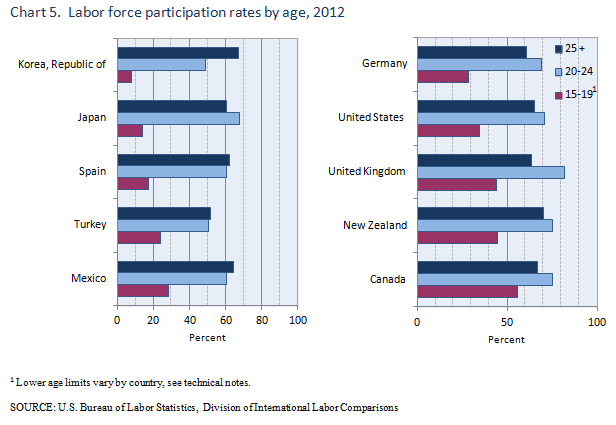
In 2012, participation rates were highest among young adults between the ages of 20 to 24 in 6 of the 10 countries for which data were available. The United Kingdom had the highest participation rates for young adults while the Republic of Korea had the lowest rates for this age group.
Adults over 25 had higher participation rates than young adults and teens (15-19) in the other 4 countries compared, which included the Republic of Korea, Mexico, Spain and Turkey.
| 2009 | 2010 | 2011 | 2012 | |||||||||
|---|---|---|---|---|---|---|---|---|---|---|---|---|
| 15-19 | 20-24 | 25+ | 15-19 | 20-24 | 25+ | 15-19 | 20-24 | 25+ | 15-19 | 20-24 | 25+ | |
| United States | 37.5 | 72.9 | 67.0 | 34.9 | 71.4 | 66.5 | 34.1 | 71.3 | 65.8 | 34.3 | 70.9 | 65.4 |
| Canada | 58.6 | 76.7 | 66.9 | 57.2 | 76.2 | 66.9 | 57.2 | 76.1 | 66.6 | 55.4 | 75.2 | 66.6 |
| Germany | 31.3 | 70.3 | 59.6 | 30.3 | 69.5 | 59.7 | 30.3 | 70.3 | 60.3 | 28.4 | 68.9 | 60.5 |
| Japan | 14.9 | 68.3 | 61.4 | 14.5 | 68.1 | 61.3 | 14.0 | 68.0 | 60.8 | 14.2 | 67.5 | 60.5 |
| Korea, Republic of | 6.2 | 49.2 | 67.0 | 7.0 | 48.9 | 67.1 | 7.6 | 48.0 | 67.3 | 7.7 | 48.9 | 67.3 |
| Mexico | 29.0 | 60.1 | 64.3 | b 28.9 | b 60.6 | b 63.8 | 28.7 | 60.1 | 63.9 | 28.4 | 60.5 | 64.6 |
| New Zealand | 51.0 | 73.4 | 69.7 | 47.8 | 73.2 | 69.8 | 45.6 | 74.6 | 70.2 | 44.3 | 75.0 | 70.0 |
| Spain | 24.3 | 65.9 | 61.1 | 21.2 | 64.0 | 61.5 | 19.2 | 62.6 | 61.7 | 17.3 | 60.6 | 61.9 |
| Turkey | 25.6 | 48.9 | 49.0 | 25.0 | 49.6 | 50.3 | 24.9 | 51.5 | 51.3 | 23.7 | 50.4 | 51.5 |
| United Kingdom | 46.4 | 82.0 | 63.1 | 44.4 | 81.9 | 63.0 | 43.4 | 81.6 | 63.1 | 44.0 | 81.8 | 63.2 |
| Note: | ||||||||||||
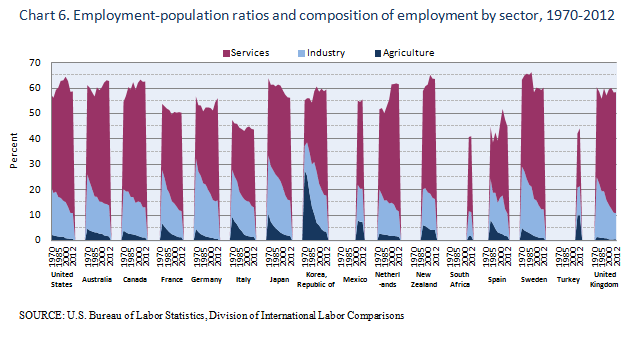
The percentage of the working age population employed has remained between 50 and 65 percent in most countries covered over the past 40 years, but the share of the working age population employed in each sector has shifted over time. The share of the working age population employed in agriculture dropped by more than half in all countries covered except the Netherlands, and the share of the working age population employed in industry (manufacturing, mining, and construction) fell in all countries covered except the Republic of Korea and Turkey. In contrast, the share of the working age population employed in services increased in all countries covered, and by 2012, the share was nearly at or above 40 percent in the majority of countries covered.
| 1980 | 2012 | |||||||
|---|---|---|---|---|---|---|---|---|
| Agriculture | Industry | Services | Not Employed | Agriculture | Industry | Services | Not employed | |
| United States | 2.0 | 17.3 | 39.8 | 40.8 | 0.9 | 10.1 | 47.6 | 41.4 |
| Australia | 3.8 | 16.7 | 37.8 | 41.7 | 1.8 | 12.2 | 48.7 | 37.3 |
| Canada | 3.0 | 16.5 | 40.9 | 39.7 | 1.4 | 12.0 | 49.1 | 37.5 |
| France | 5.6 | 19.1 | 28.1 | 47.2 | 1.5 | 10.3 | 38.5 | 49.7 |
| Germany | 2.8 | 22.8 | 27.6 | 46.9 | 0.9 | 15.0 | 40.0 | 44.0 |
| Italy | 6.5 | 17.0 | 22.4 | 54.0 | 1.6 | 11.6 | 30.5 | 56.3 |
| Japan | 6.2 | 21.5 | 33.6 | 38.7 | 2.1 | 13.9 | 40.2 | 43.8 |
| Korea, Republic of | 19.0 | 16.0 | 20.9 | 44.1 | 3.7 | 14.2 | 41.5 | 40.6 |
| Mexico | NA | NA | NA | NA | 7.5 | 13.0 | 34.9 | 44.5 |
| Netherlands | 2.7 | 15.5 | 33.9 | 47.9 | 1.7 | 9.9 | 49.7 | 38.6 |
| New Zealand | NA | NA | NA | NA | 4.3 | 12.1 | 47.1 | 36.5 |
| South Africa | NA | NA | NA | NA | 2.0 | 9.4 | 29.6 | 59.0 |
| Spain | 8.3 | 16.1 | 20.3 | 55.3 | 1.9 | 8.8 | 34.1 | 55.2 |
| Sweden | 3.7 | 20.7 | 41.3 | 34.4 | 1.3 | 11.2 | 47.6 | 39.9 |
| Turkey | NA | NA | NA | NA | 10.2 | 11.4 | 22.7 | 55.8 |
| United Kingdom | 1.5 | 21.1 | 35.9 | 41.5 | 0.7 | 10.3 | 47.4 | 41.6 |
| Note: | ||||||||
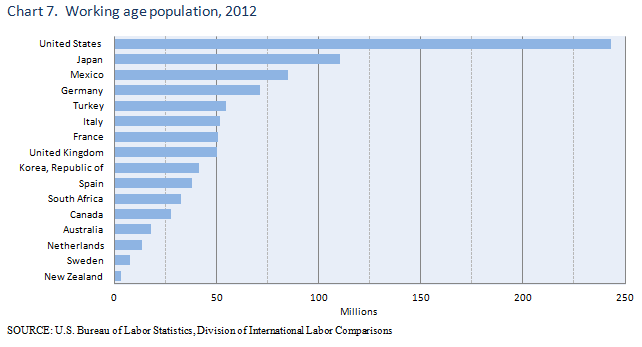
The working age population is the noninstitutional population generally 16 years and over, or the potential population available to work. For more information on working age population, see the technical notes.
The United States working age population was more than twice as large as the next largest country compared (Japan). Between 2006 and 2012, the working age population in the United States grew faster than in Japan and in all European countries compared, but grew more slowly than in the remaining countries.
| 1970 | 1980 | 1990 | 2000 | 2006 | 2007 | 2008 | 2009 | 2010 | 2011 | 2012 | ||
|---|---|---|---|---|---|---|---|---|---|---|---|---|
| United States | 137,085 | 167,745 | 189,164 | 212,577 | 228,815 | 231,867 | 233,788 | 235,801 | 237,830 | 239,618 | 243,284 | |
| Australia | 8,819 | 10,778 | 13,051 | 14,902 | 16,371 | 16,701 | 17,020 | 17,400 | 17,773 | 18,052 | 18,332 | |
| Canada | 14,528 | 18,032 | 20,852 | 23,687 | 25,711 | 26,094 | 26,486 | 26,883 | 27,250 | 27,578 | 27,922 | |
| France | 36,980 | 40,601 | 44,152 | 46,871 | 49,250 | 49,559 | 49,826 | 50,057 | 50,294 | 50,557 | 50,782 | |
| Germany | 46,094 | 49,848 | 53,438 | 69,365 | 70,892 | 70,968 | 71,021 | 70,943 | 70,858 | 70,978 | 71,274 | |
| Italy | 40,279 | 43,860 | 48,016 | 48,029 | 49,913 | 50,301 | 50,711 | 51,064 | 51,311 | 51,579 | 51,729 | |
| Japan | 78,616 | 89,078 | 100,656 | 108,120 | 110,059 | 110,419 | 110,630 | 110,761 | 110,881 | 110,882 | 110,752 | |
| Korea, Republic of | 17,468 | 24,463 | 30,887 | 36,186 | 38,762 | 39,170 | 39,598 | 40,092 | 40,590 | 41,052 | 41,582 | |
| Mexico | NA | NA | NA | NA | 74,282 | 75,538 | 76,761 | 78,314 | b 81,969 | 83,399 | 85,023 | |
| Netherlands | NA | 10,588 | 11,865 | b 12,703 | 13,128 | 13,190 | 13,271 | 13,368 | 13,460 | 13,540 | 13,629 | |
| New Zealand | NA | NA | 2,612 | 2,938 | 3,252 | 3,297 | 3,335 | 3,379 | 3,427 | 3,465 | 3,492 | |
| South Africa | NA | NA | NA | NA | NA | NA | 30,967 | 31,494 | 32,007 | 32,494 | 32,959 | |
| Spain | NA | 26,370 | 30,160 | 33,430 | 36,920 | 37,575 | 38,112 | 38,325 | 38,375 | 38,398 | 38,334 | |
| Sweden | 6,106 | 6,441 | 6,823 | 7,043 | 7,312 | 7,387 | 7,467 | 7,547 | 7,620 | 7,682 | 7,732 | |
| Turkey | NA | NA | NA | NA | 49,174 | 49,994 | 50,772 | 51,686 | 52,541 | 53,593 | 54,724 | |
| United Kingdom | NA | 42,582 | 44,717 | 46,085 | 48,197 | 48,611 | 48,998 | 49,355 | 49,726 | 50,095 | 50,473 | |
| Note: | ||||||||||||
This report presents selected labor force statistics adjusted to U.S. concepts for 1970 onward for the United States and fifteen foreign countries: Australia, Canada, France, Germany, Italy, Japan, the Republic of Korea, Mexico, the Netherlands, New Zealand, South Africa, Spain, Sweden, Turkey, and the United Kingdom. For more information see technical notes or country notes.
UNEMPLOYMENT
In the United States, unemployment includes all persons who, during the reference week:
• Had no employment,
• Were available for work, except for temporary illness, and
• Had actively sought work during the 4-week period ending with the reference week.
Active job search methods are those that have the potential to result in a job offer without further action on the part of the jobseeker. For example, sending a resume to an employer would be considered active, whereas simply reading newspaper advertisements would not.
Persons who were waiting to start a new job must have fulfilled these criteria to be considered unemployed. However, persons who were waiting to be recalled to a job from which they had been laid off need not have been looking for work.
The unemployment rate represents the percentage of persons in the labor force who are unemployed.
EMPLOYMENT
According to U.S. definitions, employment includes all persons who, during the reference week:
• Worked at least 1 hour as paid employees, worked in their own business, profession, or on their own farm, or worked at least 15 hours as unpaid workers in a family-operated enterprise, and
• All those who did not work but had jobs or businesses from which they were temporarily absent due to vacation, illness, bad weather, childcare problems, maternity or paternity leave, labor- management dispute, job training, or other family or personal reasons, regardless of whether they were paid for the time off or were seeking other jobs.
Each employed person is counted only once, even if he or she holds more than one job. For purposes of industry classification, multiple jobholders are counted in the job at which they worked the greatest number of hours during the reference week.
Persons whose only activity consisted of work around their own house (painting, repairing, or own home housework) or volunteer work for religious, charitable, and other organizations are excluded.
EMPLOYMENT BY SECTOR
Employment levels and distributions are shown for four broad economic sectors: agriculture, industry, manufacturing (a sub-sector of industry), and services.
Sectoral employment data are based on the North American Industry Classification System (NAICS) for the United States for 2000 onward, Canada for 1976 onward, and Mexico for 2005 onward. Data for Japan are based on the Japanese Standard Industrial Classification System (JSIC). For all other countries covered, sectoral employment data are based on the International Standard Industrial Classification (ISIC). Effects of the change in classification system are discussed in the country notes.
LABOR FORCE
The labor force is comprised of persons who are in employment and unemployment. All members of the working-age population are eligible for inclusion in the labor force, and those 16 and over (in the United States; age limits vary by country) who have a job or are actively looking for one are so classified. All others—those who have no job and are not looking for one—are counted as "not in the labor force."
The labor force participation rate represents the proportion of the working-age population that is in the labor force. Conversely, the inactivity rate represents the proportion of the working-age population that is not in the labor force. All persons in the civilian non-institutional working-age population who are neither employed nor unemployed are considered not in the labor force. Many who do not participate in the labor force are going to school or are retired. Family responsibilities keep others out of the labor force. Still others have a physical or mental disability which prevents them from participating in labor force activities.
WORKING-AGE POPULATION
The labor market statistics provided in this report describe the working-age population. In the United States, the working-age population is more specifically known as the civilian non- institutional working-age population:
• "Civilian" refers to persons who are not on active duty in the military;Had no employment,
• "Non-institutional" refers to persons who are not in institutions, such as prison inmates or those in a mental institution; and
• "Working-age" refers to persons 16 years of age and older.
Last Modified Date: January 21, 2025